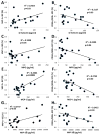Increased circulating inflammatory endothelial cells in blacks with essential hypertension
- PMID: 23798347
- PMCID: PMC3775594
- DOI: 10.1161/HYPERTENSIONAHA.113.01621
Increased circulating inflammatory endothelial cells in blacks with essential hypertension
Abstract
Morbidity and mortality attributable to hypertension are higher in black essential hypertensive (EH) compared with white EH patients, possibly related to differential effects on vascular injury and repair. Although circulating endothelial progenitor cells (EPCs) preserve endothelial integrity, inflammatory endothelial cells (IECs) detach from sites of injury and represent markers of vascular damage. We hypothesized that blood levels of IECs and inflammatory markers would be higher in black EH compared with white EH patients. Inferior vena cava and renal vein levels of CD34+/KDR+ (EPC) and VAP-1+ (IEC) cells were measured by fluorescence-activated cell sorting in white EH and black EH patients under fixed sodium intake and blockade of the renin-angiotensin system, and compared with systemic levels in normotensive control subjects (n=19 each). Renal vein and inferior vena cava levels of inflammatory cytokines and EPC homing factors were measured by Luminex. Blood pressure, serum creatinine, lipids, and antihypertensive medications did not differ between white and black EH patients, and EPC levels were decreased in both. Circulating IEC levels were elevated in black EH patients, and inversely correlated with EPC levels (R(2)=0.58; P=0.0001). Systemic levels of inflammatory cytokines and EPC homing factors were higher in black EH compared with white EH patients, and correlated directly with IECs. Renal vein inflammatory cytokines, EPCs, and IECs did not differ from their circulating levels. Most IECs expressed endothelial markers, fewer expressed progenitor cell markers, but none showed lymphocyte or phagocytic cell markers. Thus, increased release of cytokines and IECs in black EH patients may impair EPC reparative capacity and aggravate vascular damage, and accelerate hypertension-related complications.
Keywords: blacks; hypertension; inflammation; progenitor cells.
Figures


References
-
- Roger VL, Go AS, Lloyd-Jones DM, Benjamin EJ, Berry JD, Borden WB, Bravata DM, Dai S, Ford ES, Fox CS, Fullerton HJ, Gillespie C, Hailpern SM, Heit JA, Howard VJ, Kissela BM, Kittner SJ, Lackland DT, Lichtman JH, Lisabeth LD, Makuc DM, Marcus GM, Marelli A, Matchar DB, Moy CS, Mozaffarian D, Mussolino ME, Nichol G, Paynter NP, Soliman EZ, Sorlie PD, Sotoodehnia N, Turan TN, Virani SS, Wong ND, Woo D, Turner MB. Heart disease and stroke statistics--2012 update: A report from the american heart association. Circulation. 2012;125:e2–e220. - PMC - PubMed
-
- McClellan W, Tuttle E, Issa A. Racial differences in the incidence of hypertensive end-stage renal disease (esrd) are not entirely explained by differences in the prevalence of hypertension. Am J Kidney Dis. 1988;12:285–290. - PubMed
-
- Folsom AR, Burke GL, Byers CL, Hutchinson RG, Heiss G, Flack JM, Jacobs DR, Jr, Caan B. Implications of obesity for cardiovascular disease in blacks: The cardia and aric studies. Am J Clin Nutr. 1991;53:1604S–1611S. - PubMed
-
- Aviv A, Hollenberg NK, Weder A. Urinary potassium excretion and sodium sensitivity in blacks. Hypertension. 2004;43:707–713. - PubMed
Publication types
MeSH terms
Substances
Grants and funding
LinkOut - more resources
Full Text Sources
Other Literature Sources
Medical

